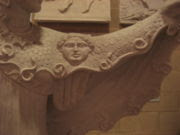Aegis
Aegis
From Wikipedia, the free encyclopedia
Jump to: navigation, search
For other uses, see Aegis (disambiguation).
"Ægis" has entered modern English to mean a shield, protection, or sponsorship, originally from the name of the mythological protective shield of Zeus. The name has been extended to many other entities, such as the Aegis combat system used by the U.S. Navy; Aegis School of Business based in Mumbai, and the concept of a protective shield is found in other mythologies, while its form varies across sources.
The concept of doing something "under someone's ægis" means doing something under protection of a powerful, knowledgeable, or benevolent source. The word ægis is identified with protection by a strong force with its roots in Classical mythology, specifically Greek myth adopted by the Romans; there are parallels in Norse mythology, and in Egyptian, where the Greek word aegis is applied by extension.
Contents[hide]
1 In Greek mythology
2 Locating the aegis
2.1 Etymology
3 In Egyptian mythology
4 In Norse mythology
5 Notes
//
[edit] In Greek mythology
Closeup of a plaster cast of a Roman sculpture of Athena wearing the Aegis, Classics Department, Jesus College, Cambridge University.
The ægis (Greek Αιγίς), already attested in the Iliad, is the shield or buckler of Zeus, which according to Homer was fashioned for him by Hephaestus, furnished with golden tassels and bearing the gorgoneion (Medusa's head) in the central boss. The Attic vase-painters retained an archaic tradition that the tassels had originally been serpents in their representations of the ægis.
When the Olympian shakes the ægis, Mount Ida is wrapped in clouds, the thunder rolls and men are smitten with fear. "Ægis-bearing Zeus", as he is in the Iliad, sometimes lends it to Athena and (rarely) to Apollo: in the Iliad Zeus sends Apollo to revive the wounded Hector and, holding the ægis, Apollo charges the Achaeans, pushing them back to their ships drawn up on the shore. According to Edith Hamilton's Mythology: Timeless Tales of Gods and Heroes [1], the Aegis is Zeus' breastplate, and was "awful to behold."
From Wikipedia, the free encyclopedia
Jump to: navigation, search
For other uses, see Aegis (disambiguation).
"Ægis" has entered modern English to mean a shield, protection, or sponsorship, originally from the name of the mythological protective shield of Zeus. The name has been extended to many other entities, such as the Aegis combat system used by the U.S. Navy; Aegis School of Business based in Mumbai, and the concept of a protective shield is found in other mythologies, while its form varies across sources.
The concept of doing something "under someone's ægis" means doing something under protection of a powerful, knowledgeable, or benevolent source. The word ægis is identified with protection by a strong force with its roots in Classical mythology, specifically Greek myth adopted by the Romans; there are parallels in Norse mythology, and in Egyptian, where the Greek word aegis is applied by extension.
Contents[hide]
1 In Greek mythology
2 Locating the aegis
2.1 Etymology
3 In Egyptian mythology
4 In Norse mythology
5 Notes
//
[edit] In Greek mythology
Closeup of a plaster cast of a Roman sculpture of Athena wearing the Aegis, Classics Department, Jesus College, Cambridge University.
The ægis (Greek Αιγίς), already attested in the Iliad, is the shield or buckler of Zeus, which according to Homer was fashioned for him by Hephaestus, furnished with golden tassels and bearing the gorgoneion (Medusa's head) in the central boss. The Attic vase-painters retained an archaic tradition that the tassels had originally been serpents in their representations of the ægis.
When the Olympian shakes the ægis, Mount Ida is wrapped in clouds, the thunder rolls and men are smitten with fear. "Ægis-bearing Zeus", as he is in the Iliad, sometimes lends it to Athena and (rarely) to Apollo: in the Iliad Zeus sends Apollo to revive the wounded Hector and, holding the ægis, Apollo charges the Achaeans, pushing them back to their ships drawn up on the shore. According to Edith Hamilton's Mythology: Timeless Tales of Gods and Heroes [1], the Aegis is Zeus' breastplate, and was "awful to behold."

[edit] Locating the aegis
Later Greeks always detected that there was something alien and uncanny about the aegis. It was supposed by Euripides (Ion, 995) that the Gorgon was the original possessor of this goatskin,[2] yet the usual understanding is that the gorgoneon was added to the aegis, a votive gift from a grateful Perseus.
There is also the origin myth that represents the ægis as a fire-breathing chthonic monster like the Chimera, which was slain and flayed by Athena, who afterwards wore its skin as a cuirass (Diodorus Siculus iii. 70).
Still others say it was the skin of the monstrous giant Pallas whom Athena overcame and whose name she attached to her own (John Tzetzes, On Lycophron, 355).
In a late rendering by Hyginus, (Poetical Astronomy ii. 13) Zeus is said to have used the skin of the goat Amalthea (aigis "goat-skin") which suckled him in Crete, as a shield when he went forth to do battle against the titans.
Herodotus (Histories iv.189) thought he had identified the source of the ægis in Libya, which was always a distant territory of ancient magic for the Greeks:
Athene's garments and ægis were borrowed by the Greeks from the Libyan women, who are dressed in exactly the same way, except that their leather garments are fringed with thongs, not serpents.
Robert Graves in The Greek Myths (1955; 1960) asserts that the ægis in its Libyan sense had been a shamanic pouch containing various ritual objects, bearing the device of a monstrous serpent-haired visage with tusk-like teeth and a protruding tongue which was meant to frighten away the uninitiated.
Another version[citation needed] describes it to have been really the goat's skin used as a belt to support the shield. When so used it would generally be fastened on the right shoulder, and would partially envelop the chest as it passed obliquely round in front and behind to be attached to the shield under the left arm. Hence, by metonymy, it would be employed to denote at times the shield which it supported, and at other times a cuirass, the purpose of which it in part served. In accordance with this double meaning, the ægis appears in works of art sometimes as an animal's skin thrown over the shoulders and arms, and sometimes as a cuirass, with a border of snakes corresponding to the tassels of Homer, usually with the Gorgon's head, the gorgoneion, in the centre. It is often represented on the statues of Roman emperors, heroes, and warriors, and on cameos and vases.
The current modern interpretation is that the Hittite sacral hieratic hunting bag (kursas), a rough and shaggy goatskin that has been firmly established in literary texts and iconography by H.G. Güterbock,[3] is the most likely source of the aegis.[4].
[edit] Etymology
Greek Αιγις has 3 meanings:-
"violent windstorm", from the verb 'αïσσω (stem 'αïγ-) = "I rush or move violently".
The gods' shield as described above.
"goatskin coat", from treating the word as "something grammatically feminine pertaining to goat (Greek αιξ (stem αιγ-))".
The original meaning may have been #1, and Ζευς 'Αιγιοχος = "Zeus who holds the aegis" may have originally meant "Sky/Heaven, who holds the storm". The transition to the meaning "shield" may have come by folk-etymology among a people familiar with draping an animal skin over the left arm as a shield.
[edit] In Egyptian mythology
The ægis also appears in Egyptian mythology. The goddess Bast was sometimes depicted holding a ceremonial sistrum in one hand and an ægis in the other -- the ægis usually resembling a collar or gorget embellished with a lion's head.
[edit] In Norse mythology
In Norse Mythology, the dwarf Fafnir (best known in the form of a dragon slain by Sigurðr) bears on his forehead the Ægis-helm (ON ægishjálmr), or Ægir's helmet. It may be an actual helmet or a magical sign with a rather poetic name. Ægir is an unrelated Old Norse word meaning "terror" and the name of a destructive giant associated with the sea. "Ægis" is the genitive (possessive) form of ægir and has no relation to the Greek word aigis.
[edit] Notes
^ Part I, section I (Warner Books' United States Paperback Edition)
^ Noted by Graves 1960, 9.a; Karl Kerenyi, The Gods of the Greeks 1951, p 50.
^ Güterbock, Perspectives on Hittite Civilization: Selected Writings (Chicago 1997).
^ Calvert Watkins "A Distant Anatolian Echo in Pindar: The Origin of the Aegis Again", Harvard Studies in Classical Philology 100 (2000), pp. 1-14. on JSTOR
Retrieved from "http://en.wikipedia.org/wiki/Aegis"
Categories: Articles with unsourced statements since February 2007 All articles with unsourced statements Mythological objects Motif of harmful sensation Ornaments Shields Mythological weapons


Comments
Post a Comment